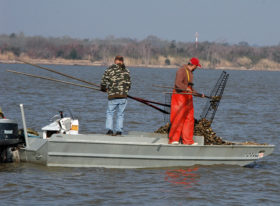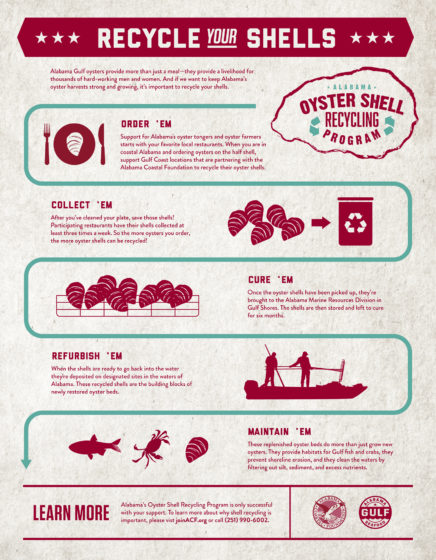Oyster shell recycling program off to hot start

Oyster consumption has been occurring along the Alabama Gulf Coast for millennia with the Indian Shell Mound on Dauphin Island as historical evidence.
Fast forward to the 21st century and dining on oysters has increased exponentially. Instead of creating shell mounds, the Alabama Oyster Shell Recycling Program is designed to use the discarded shells in more creative and productive ways.
With the Alabama Coastal Foundation leading the way, a group of individuals and organizations started devising a plan to recycle the shells. Those involved included Chris Sherrill with the Flora-Bama Yacht Club, Chandra Wright with the Alabama Gulf Coast Convention and Visitors Bureau, Alabama Marine Resources Division Director Chris Blankenship and Judy Haner with The Nature Conservancy.
“We’ve needed an oyster shell recycling program in Alabama for a while,” Blankenship said. “We have been meeting to put together a shell recycling program that would work long term.
“There was an opportunity to get a grant from the National Fish and Wildlife Foundation (NFWF) to implement a pilot program to get this started. The Alabama Coastal Foundation stepped up as the lead agency and received the grant to begin a two-year pilot program to demonstrate the effectiveness of a shell recycling program in Alabama.”
Mark Berte, Executive Director of the Alabama Coastal Foundation, said the grant from NFWF is for a two-part process – education and sustainability.
“Our whole mission is to improve and protect Alabama’s coastal environment through cooperation, education and participation,” Berte said last week at Gulf Shores. “And this program is all of the above. We work with restaurants to educate them that what they thought was trash is actually a valuable natural resource. The more shells we collect, the more shells we can get back into the water that will allow more oysters to grow and complete a nice, positive cycle.”
The first phase of the shell recycling program went into effect in the fall of 2016 with six restaurants along Battleship Parkway (Causeway) at the head of Mobile Bay.
“Those restaurants are all close together, so it was easy for Republic Waste Services to run the route, pick up the shells and do the hauling,” Blankenship said. “The shells are trucked to our Marine Resources property in Gulf Shores, where the shells are stored and seasoned so they can be used in several different projects, from replenishing reefs to grow more oysters to shoreline stabilization projects.
“There will be myriad uses for the shells, including oyster gardening. The important part is they are not going to a landfill. Now they’ll be going back in the water to grow more oysters.”
Larval oysters, known as spat, must attach to a hard surface to grow, and recycled oyster shells can provide an abundance of this vital structure.
Last week, the recycling program expanded with an additional collection route in the Gulf Shores and Orange Beach area, which puts the total number of restaurants involved in the recycling program at 13.
“The program has gained a lot of good public support,” Blankenship said. “We’re really glad this has taken off. The program is growing.”
A celebration of the expanded program was held at two locations on the Alabama coast last week, including the Original Oyster House in Gulf Shores.
Joe Roszkowski, co-founder of the Original Oyster House restaurants, said the number of oysters that go through their restaurants will quickly add up.
“We serve quite a few oysters,” Roszkowski said last week at the ribbon-cutting ceremony. “In fact, we serve about 5,000 pounds a week in the summertime; that’s are quite a few shells. We know what oysters mean to the community and sponsor the oyster trail and Mobile’s oyster gardening program. We learn how oysters impact our environment, our community and, of course, our health. For years these dedicated scientists, environmentalists and educators have worked to get oyster shells back in the water. We’re so fortunate to be given the opportunity to help pilot Alabama’s first oyster shell recycling program at our location on the Causeway.
“This program aligns with our core values of stewardship and will enhance the oyster population and help prevent coastal erosion. Best of all, this program will bring attention to how important it is to get the shells back to the reefs instead of the landfill.”
As of the end of last week, more than 650,000 oyster shells had been collected.
Gulf Shores Mayor Robert Craft said the 2010 oil spill is a reminder that we should never take our environment for granted.
“This is an important first step forward,” Mayor Craft said. “This is what I think we learned, or should have learned, from the oil spill. When the oil spill happened and we couldn’t fish in the waters, eat the seafood or enjoy the environment, what happened was that nobody came. They don’t come here because they like the mayor or Gulf Shores. They came here for the environment. Because when it couldn’t be used and enjoyed, people didn’t come.
“If you connect those dots, what is the most important thing we need to do to maintain the quality of life in our community that is so special? That is to protect the environment. Part of that environment is having oysters that we enjoy eating. Our challenge here by recycling oyster shells is to recreate the reefs and grow more oysters.”
Blankenship said the goal of the program is to eventually get all of the oyster shells that are discarded at restaurants along the Alabama Gulf Coast.
“Right now, we want to get at least the top half of the oyster that doesn’t go to the table,” he said. “We’re working with the restaurants to collect the bottom half of the shells from the table so we can get all the oyster shells.
“Nothing grows oysters as well as oyster shells.”
Blankenship said the program set a conservative goal of collecting 2.7 million shells, but it should easily exceed that number.
“In two years we’ll be well over the goal with the way the program has started,” he said. “The ultimate goal would be to make the recycling program self-sustaining after those two years, after the consumers and restaurants see the value of recycling those oyster shells. Instead of having the grant help pay for the transportation of the shells, the money the restaurants pay for the shells to go to the landfill can be used in the recycling program. Restaurants pay by the ton to haul off waste. Oyster shells that go in the trash count toward that tonnage. The goal is to get the restaurants to separate out the shells, and instead of hauling them to the landfill, they would go to the Marine Resources Division to be recycled.
“The value of the shells that can be used for restoration projects would make this self-sustaining after two years.”
Blankenship predicts the consumption of oysters along the Alabama coast will continue to grow, which will mean more shells for recycling.
“Oysters are becoming more popular,” he said. “There used to be a limited number of people who ate oysters. Now it’s becoming a much more popular seafood item.
“With the growth of the oyster aquaculture industry in Alabama, we only see that market getting stronger.”
David Rainer is public information manager and outdoor columnist for the Alabama Department of Conservation and Natural Resources. His column appears weekly in The West Alabama Watchman.


